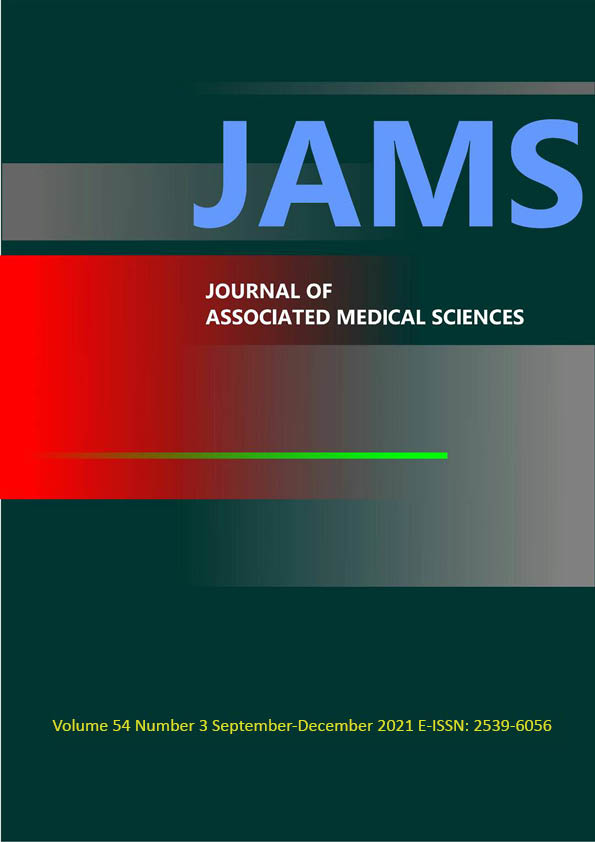Effect of acquisition time on image quality and lesion detectability with 131I SPECT: A phantom study
Main Article Content
Abstract
Background: One important parameter in single-photon emission computed tomography (SPECT) is the acquisition time. Longer acquisition time can reduce noise, improving image quality while patient motion might be presented.
Objectives: This study intended to examine the effect of acquisition time on qualitative and quantitative analysis of 131I (Iodine-131) SPECT.
Materials and methods: A National Electrical Manufacturers Association/International Electrotechnical Commission (NEMA/IEC) phantom with a set of fillable spheres was filled with 131I solution to generate two conditions: (a) hot lesion with no background and (b) hot lesion with a warm background at a ratio of 10:1. SPECT images were acquired with acquisition times per frame of 20, 30, 40, and 90 second/frame (s/f).
Results: Qualitative assessment in the no background condition showed that all spheres were visible at all acquisition settings, while the smallest sphere in the images in hot lesion with a warm background at a ratio of 10:1 was not visible even at the longest acquisition time of 90 s/f. Quantitative analysis revealed that the contrast and contrast-to-noise ratio (CNR) increased upon extending the acquisition time in both conditions. Interestingly, the statistical results indicated that the mean CNRs acquired at 20 or 30 s/f were not significantly different when compared with 40 s/f for no background. However, for the warm background, the mean CNRs at 20 s/f were significantly different than those at 40 s/f, while they were not significantly different at 30 s/f.
Conclusion: The acquisition time for no background condition can be optimized, while the image quality is still clinically acceptable. For the warm background, the acquisition time can be shortened; however, the time selection must be carefully considered.
Article Details

This work is licensed under a Creative Commons Attribution-NonCommercial-NoDerivatives 4.0 International License.
Personal views expressed by the contributors in their articles are not necessarily those of the Journal of Associated Medical Sciences, Faculty of Associated Medical Sciences, Chiang Mai University.
References
Xue Y-L, Qiu Z-L, Perotti G, Salvatori M, Luo Q-Y. 131I SPECT/CT: a one-station imaging modality in the management of differentiated thyroid cancer. Clinical and Translational Imaging. 2013; 1(3): 163-73.
Salvatori M, Perotti G, Villani MF, Mazza R, Maussier ML, Indovina L, et al. Determining the appropriate time of execution of an I-131 post-therapy whole-body scan: comparison between early and late imaging. Nucl Med Commun. 2013; 34(9): 900-8.
Beijst C, Kist JW, Elschot M, Viergever MA, Hoekstra OS, de Keizer B, et al. Quantitative Comparison of 124I PET/CT and 131I SPECT/CT Detectability. Journal of Nuclear Medicine. 2016; 57(1): 103-8.
Kenneth FK, Anastasia Y, Yuni KD. Recovery of total I-131 activity within focal volumes using SPECT and 3D OSEM. Physics in Medicine and Biology. 2007; 52(3): 777.
Rault E, Vandenberghe S, Van Holen R, De Beenhouwer J, Staelens S, Lemahieu I. Comparison of image quality of different iodine isotopes (I-123, I-124, and I-131). Cancer Biother Radiopharm. 2007; 22(3): 423-30.
Oh JR, Byun BH, Hong SP, Chong A, Kim J, Yoo SW, et al. Comparison of (1)(3)(1)I whole-body imaging, (1)(3)(1)I SPECT/CT, and (1)(8)F-FDG PET/CT in the detection of metastatic thyroid cancer. Eur J Nucl Med Mol Imaging. 2011; 38(8): 1459-68.
Avram AM. Radioiodine Scintigraphy with SPECT/CT: An Important Diagnostic Tool for Thyroid Cancer Staging and Risk Stratification. Journal of Nuclear Medicine. 2012; 53(5): 754-64.
He B, Frey EC. Effects of shortened acquisition time on accuracy and precision of quantitative estimates of organ activity. Medical physics. 2010; 37(4): 1807-15.
Bar R, Przewloka K, Karry R, Frenkel A, Golz A, Keidar Z. Half-time SPECT acquisition with resolution recovery for Tc-MIBI SPECT imaging in the assessment of hyperparathyroidism. Molecular Imaging and Biology. 2012; 14(5): 647-51.
Aldridge MD, Waddington WW, Dickson JC, Prakash V, Ell PJ, Bomanji JB. Clinical evaluation of reducing acquisition time on single-photon emission computed tomography image quality using proprietary resolution recovery software. Nuclear medicine communications. 2013; 34(11): 1116-23.
Thientunyakit T, Taerakul T, Chaudakshetrin P, Ubolnuch K, Sirithongjak K. A comparison of the diagnostic performance of half-time SPECT and multiplanar pelvic bone scan in patients with significant bladder artifacts. Nuclear medicine communications. 2013; 34(3): 233-9.
Tan HK, Wassenaar RW, Zeng W. Collimator selection, acquisition speed, and visual assessment of 131I-tositumomab biodistribution in a phantom model. J Nucl Med Technol. 2006; 34(4): 224-7.
Pereira JM, Stabin MG, Lima FRA, Guimarães M, Forrester JW. Image Quantification for Radiation Dose Calculations – Limitations and Uncertainties. Health physics. 2010; 99(5): 688-701.
Van Gils CA, Beijst C, Van Rooij R, De Jong HW. Impact of reconstruction parameters on quantitative I-131 SPECT. Phys Med Biol. 2016; 61(14): 5166-82.
Trägårdh E, Johansson L, Olofsson C, Valind S, Edenbrandt L. Nuclear medicine technologists are able to accurately determine when a myocardial perfusion rest study is necessary. BMC Medical Informatics and Decision Making. 2012; 12(1): 97.
Viera AJ, Garrett JM. Understanding interobserver agreement: the kappa statistic. Fam Med. 2005; 37(5): 360-3.
Erdi YE. Limits of tumor detectability in nuclear medicine and PET. Molecular imaging and radionuclide therapy. 2012; 21(1): 23.
Kessler RM, Ellis JR, Jr., Eden M. Analysis of emission tomographic scan data: limitations imposed by resolution and background. J Comput Assist Tomogr. 1984; 8(3): 514-22.
Zaidi H. Quantitative Analysis in Nuclear Medicine Imaging: Springer US; 2006.
Burg S, Dupas A, Stute S, Dieudonné A, Huet P, Guludec DL, et al. Partial volume effect estimation and correction in the aortic vascular wall in PET imaging. Physics in Medicine and Biology. 2013; 58(21):7 527.
Dewaraja YK, Ljungberg M, Green AJ, Zanzonico PB, Frey EC, Bolch WE, et al. MIRD pamphlet No. 24: Guidelines for quantitative 131I SPECT in dosimetry applications. Journal of Nuclear Medicine. 2013; 54(12): 2182-8.
Elschot M, Vermolen BJ, Lam MG, de Keizer B, van den Bosch MA, de Jong HW. Quantitative comparison of PET and Bremsstrahlung SPECT for imaging the in vivo yttrium-90 microsphere distribution after liver radioembolization. PLoS One. 2013; 8(2): e55742.
Brambilla M. Performance evaluation of hardware and software for spect cardiac imaging. Physica Medica. 2016; 32, Supplement 3: 179.


